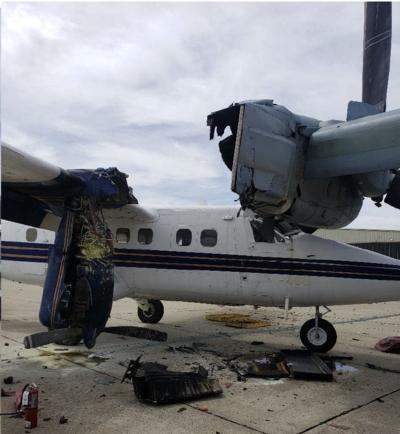Somewhere Out There Is An Insurance Agent Contemplating Ending It All...
In one of the most expensive ground accidents of recent record, a ramp collision between a Skydiving operation's DHC-6 Twin Otter and a USMC MV-22 Osprey has to set some kind of record... both in terms of money, as well as paperwork/heartburn.

The early morning, May 30, mishap took place at Brown Field Municipal Airport, a San Diego GA field about a mile and half North of the US-Mexico border.
An MV-22 Osprey belonging to Marine Medium Tiltrotor Squadron (VMM) 163, based at Miramar MCAS, had been conducting some 'routine' training operations in the area and eventually parked the Osprey at Brown. No Marines were present at the time of the mishap as the Twin Otter started up and proceeded to taxi into the MV-22 under power.
According to city of San Diego documents, "Aircraft accident encountered during opening inspection on Ramp 6. Two airport users onsite deployed fire extinguishers. On arrival, noted Twin Otter (DHC-6-100), N52FW had impacted Marines V-22 Osprey. The occupied Twin Otter impacted the unoccupied Osprey on the left wing, engine, and propeller blade with its nose, left and right propellers. Twin Otter right engine was hanging by its mount, left engine in place, both engine propellers bent, nose damage, broken right windscreen, and collapsed right windscreen frame. Osprey damage to blade on left propeller, left engine compartment, wing, landing gear moved, and right engine propeller blade impacted the ground. Debris littered Ramp 6 including pieces from both aircraft."

CSD documents also noted that, "NTSB talked to the pilot and the following statement was taken: Pilot Christopher Sanders was picking up the Twin Otter at SDM to take it over to 0CL3 (Nicholas Field) for skydiving operations after Aircal worked on the aircraft the last two weeks on several issues. Mr. Sanders arrived at the aircraft at approximately 0915 and began preflight operations. The maintenance service sheet was still in the aircraft and Mr. Sanders checked with Mic Fejer (Aircal) and Mic released the aircraft. Right engine was turned on first and there were no issues. Left engine also started without incident. Then the aircraft began to roll forward. Mr. Sanders checked the parking brake, and pressed on the brakes and the brakes were not responsive. Mr. Sanders pulled back power as the aircraft moved to left and impacted the Osprey. Mr. Sanders exited the aircraft and checked for damage and injuries and waited for authorities to arrive."
The marines have classified this accident as a 'Class A' mishap -- which estimates the damage to be at least $2 million. The Osprey reportedly suffered damage primarily on its left side, as well as to the left engine enclosure, wing and landing gear, as well as to both the left and right rotors.
The 1967 Twin Otter, a De Havilland DHC-6-100, N52FW, is registered to Kapowsin Air Sports. Damage estimates for the Twin Otter wee not readily available though a local official indicated that the aircraft was probably totaled.
 Aero-TV: DeltaHawks Diesel Power Steps Into the Spotlight
Aero-TV: DeltaHawks Diesel Power Steps Into the Spotlight NTSB Prelim: Mooney Aircraft Corp. M20K
NTSB Prelim: Mooney Aircraft Corp. M20K ANN FAQ: Turn On Post Notifications
ANN FAQ: Turn On Post Notifications ANN's Daily Aero-Linx (12.20.25)
ANN's Daily Aero-Linx (12.20.25) Aero-News: Quote of the Day (12.20.25)
Aero-News: Quote of the Day (12.20.25)




